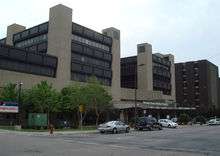Hennepin County Medical Center

Hennepin County Medical Center (HCMC) is a Level I trauma center based in Minneapolis, Minnesota, the county seat of Hennepin County. The primary 455-bed facility is located on five city blocks across the street from U.S. Bank Stadium, with neighborhood clinics in the Minneapolis Whittier and East Lake neighborhoods, and the suburban communities of Brooklyn Center, Brooklyn Park, Golden Valley, St. Anthony and Richfield. Some patients come a long distance to be treated at HCMC because of the recognized trauma surgery specialists, transplant services, stroke specialists, advanced endoscopy/hepatobilliary center, and hyperbaric oxygen chamber.
History

The original hospital building, established in 1887 as Minneapolis City Hospital, before being referred to as "General Hospital" or "City Hospital," sat a block from its current main location.[1] Ownership was transferred to the county in 1964, when it was renamed Hennepin County General Hospital. The hospital took its current name in 1974. By the late 1960s, the hospital was a disorganized patchwork of buildings, leading to the decision to clear and rebuild the facility.[1] The current hospital facility was completed in 1976, following a $25 million bond passed by voters in 1969. The hospital expanded in 1991 when the adjacent Metropolitan-Mount Sinai Medical Center closed. It gained Level I trauma center status in 1989, the first such site in the state. The hospital underwent a governance change in January 2007, which created a new governing entity with greater autonomy from the county government. The public mission of the hospital did not change, but this transition was made in an attempt to ensure the long-term viability of the hospital. In 2012 the hospital partnered with NorthPoint Health and Wellness Center, Metropolitan Health Plan, and Hennepin County’s Human Services and Public Health Department to form an accountable care organization called Hennepin Health. By February 2013, Hennepin Health had enrolled 6,000 clients.[2]
Residency programs
HCMC has independent residency programs in dentistry, pharmacy practice, emergency medicine, surgery, psychiatry, family medicine, podiatric surgery and internal medicine. In addition, it is a rotating site for many programs from the University of Minnesota, including oral and maxillofacial surgery, otolaryngology, obstetrics/gynecology, orthopedics, neurosurgery, neurology, ophthalmology, pediatrics, and many medical subspecialty fellowships. It has independent fellowships in geriatrics, critical care medicine, sleep medicine and nephrology.
Internship opportunity
Students from UCIMED, a medical school located in Costa Rica, are given the opportunity to complete an internship at the hospital. The initiative started thanks to an agreement signed on February 2006. Many of the students from UCIMED go on to work as residents at HCMC.
Emergency medical services

HCMC also provides emergency medical services for the cities of Minneapolis, Golden Valley, Shorewood, Eden Prairie, St. Louis Park, Hopkins, St. Anthony, Woodland, Excelsior, Deephaven, Tonka Bay, Richfield, and the majority of the municipality of Minnetonka. HCMC EMS utilizes 30 type III ambulances, 3 medical director vehicles, 2 Community Paramedic vehicles and 2 EMS Command units utilized in its fleet. All 911 response vehicles are equipped with state of the art equipment, and each rig is staffed by two state certified paramedics. A MCI trailer is on hand for MCI incidents in its coverage area. HCMC EMS habitually logs over 75,000 911 calls every year from an urban/suburban population base of roughly 770,000.
See also
References
- 1 2 Millett, Larry (2007). AIA Guide to the Twin Cities: The Essential Source on the Architecture of Minneapolis and St. Paul. Minnesota Historical Society Press. pp. 283–84. ISBN 0-87351-540-4.
- ↑ "County-Based Accountable Care Organization for Medicaid Enrollees Features Shared Risk, Electronic Data Sharing, and Various Improvement Initiatives, Leading to Lower Utilization and Costs". Agency for Healthcare Research and Quality. 2013-05-08. Retrieved 2013-05-10.
Further reading
- Nathanson, Iric, and Thomas R. Mattison. “Origins of a Modern Medical Center: Minneapolis City Hospital, 1887–1907,” Minnesota History 63 (Fall 2012), 114–23. Heavily illustrated.
External links
Coordinates: 44°58′21″N 93°15′43″W / 44.97250°N 93.26194°W